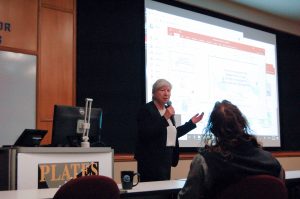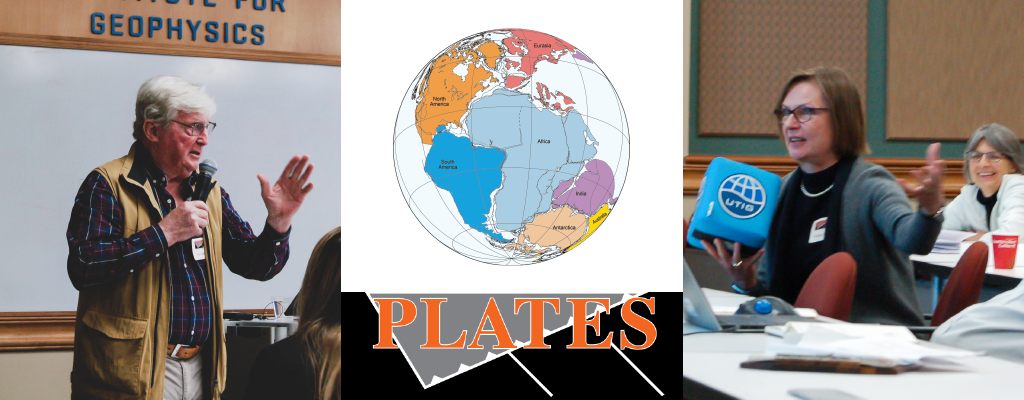View the PLATES Symposium photo album (Facebook)
The PLATES program has marked a key milestone in the study of plate tectonics by holding a symposium to celebrate 30 years of PLATES at the University of Texas Institute for Geophysics (UTIG). The symposium, held March 25-26, brought together colleagues from across the world to reflect on some of the program’s key achievements, present new research and discuss the future of plate tectonics research.
PLATES is an industry-funded project dedicated to the research of plate tectonics and geological reconstructions. The project studies evidence of how plates move around the Earth and creates accurate reconstructions of our planet’s continents changing over time. The animations, databases and tools created by the project have been used for diverse purposes, from oil and gas exploration to tracking animal migration in the Earth’s distant past. PLATES scientists include Lawrence Lawver, Ian Dalziel and Ian Norton.
PLATES co-investigator, Ian Dalziel, who is also a Research Professor at UTIG, said that the symposium was a success because it tackled issues of importance to the community by talks from well-respected scientists. “I think the quality of the speakers has showed up in the talks that we’ve been having,” he said. “People have really tried to address the questions that we posed to them, rather than just giving their own talk. I think that’s worked out very well.”
PLATES co-investigator and senior research scientist at UTIG, Larry Lawver, who has been with the project since its inception, agreed. “I think the talks were excellent. They emphasized the continuing challenges facing plate tectonics research and importance of getting good data.”
“We’ve heard from people involved in trying to understand the long-term evolution of the Earth and how things have changed over the last tens to hundreds of millions of years,” added Becker. “It’s been exciting to see colleagues from all over the world debate issues old and new, and to see how we might move those issues forward.”
Dalziel said the symposium served three purposes: to assess how far plate reconstructions have progressed since the days before plate tectonics, to understand where the field is heading, and to explore how PLATES might be relevant within other earth sciences. “We’ve been able to take stock of where plate tectonic reconstructions have got to over the years,” added Dalziel, “but with a view to where the whole field is leading and what areas of the Earth sciences PLATES is relevant to.”
One such area is biology – in particular, evolutionary biology. Speaking on the morning of day one, Julia Clarke, Professor of Geological Sciences at the Jackson School of Geosciences, described how plate reconstructions are changing how we think about biodiversity dynamics and the origins of species.

Commenting about Dr. Clarke’s talk, UTIG research scientist and co-convener Thorsten Becker, said, “I think it was exciting today to hear about progress in the biology community, to understand how biodiversity responds to (tectonic) forcing, and to see possible evidence really linking the evolution of life to tectonics in a more meaningful way.”
Among other highlights, Professor of Geology and Geophysics at Caltech, Joann Stock, gave a compelling explanation for the origins of the Altiplano plateau, an unusually broad section of the central Andes. “I think Joann Stock did an excellent job of demonstrating one of the possibilities for the Altiplano uplift,” said Lawver. “She pointed out that the edges of the Manihiki Plateau were just sheared off and headed somewhere else.” Those edges formed microplates that may have ended up being dragged into the South American trench, choking it and forcing the uplift of the Altiplano.
Other talks looked at recent applications of machine-learning in plate modeling, how new satellite data has improved plate reconstructions, whether plate tectonics is driving the global carbon cycle, and a lively debate on the role of paleomagnetism in understanding Earth evolution.
Both Becker and Lawver agree that the future of plate tectonics research must include more than just new data. “Somebody referred to the next phase as PLATES 3D and I said ‘no, it’s PLATES 4D’,” said Lawver. “I think PLATES 4D is the right term because the way forward is really about taking it into the fourth dimension. When we look at the surface of a globe, which is what we use in PLATES, it is literally just two dimensions and time is the third dimension. But what we really need is this fourth dimension, which is the depth.”
Becker specified what that additional dimension could involve. “I think the future of PLATES has to involve an understanding of the dynamics of mantle convection and the transport of sediments and volatiles – and how that all factors into Earth evolution,” he explained.
Whatever the future holds for plate tectonics research, Lawver believes that one of the big takeaways from the symposium was that advanced data processing techniques such as data mining and artificial intelligence will always depend on good science to reach the right conclusion.
“I guess there’s as much art as science in plate tectonics,” he said. “You have to have the ability to understand that even though your model looks perfect, if it winds up contradicting geology on two different continents, it doesn’t mean the geology is wrong it means you need to rethink the model. And I think the speakers did a good job of demonstrating that.”
All the talks were recorded and are available to watch online:
March 25 AM
(8:00 am to 12:15 pm)

